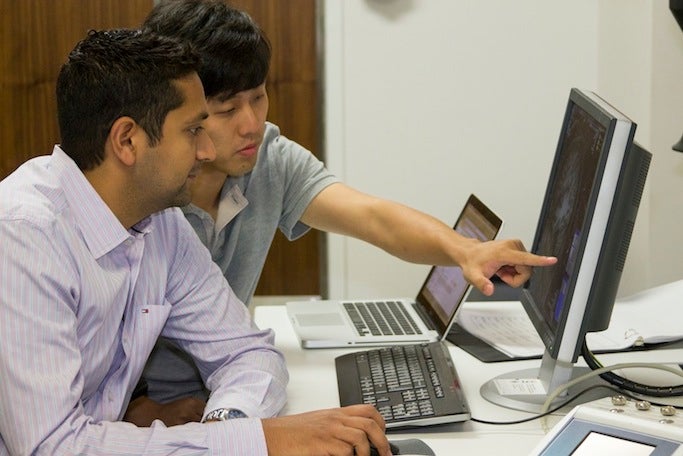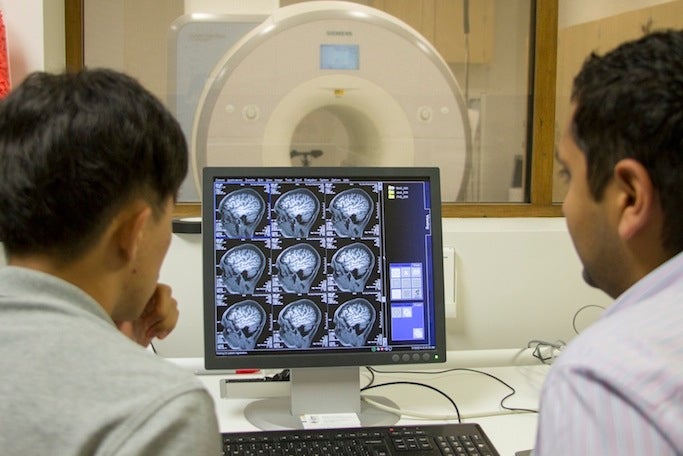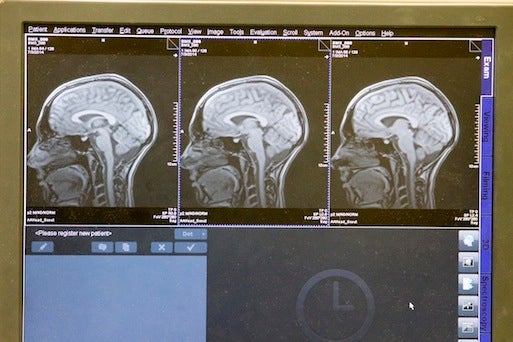Training the Brain

Say you’re at a cocktail party, crowded restaurant or concert. Have you wondered how you are able to filter out noises and focus your attention on conversations or listen for specific sounds?
The answer is through the use of the efferent auditory system, which uses feedback loops to filter sounds deemed relevant. Some individuals—particularly musicians—are able to fine-tune it at higher levels. While adults have more evolved feedback system than children, many individuals have difficulty or disorders affecting their ability to refine sounds.

student Han-Gyol Yi.
“The adult brain is better at predicting what to listen for in these situations,” said Bharath Chandrasekaran, assistant professor and neuroscientist in the Department of Communication Sciences and Disorders in the Moody College of Communication. “Children are like sponges and absorb sounds more passively, making it harder for them to pick and choose what is relevant or irrelevant, especially if they have dyslexia or auditory impairments.”
Citing “brain training” programs such as Lumosity, Chandrasekaran said parts of the brain can be stimulated using training programs and may be applicable for use in clinical treatment of hearing disorders in both children and adults.
Now, his research has been supported through a $2 million, five-year grant from the National Institutes of Health. Titled “Online modulation of brainstem responses to speech,” Chandrasekaran will explore what he calls “the final frontier” of research on the topic: how the brain reorganizes itself in response to new auditory learning experiences. He will serve as principal investigator in collaboration with co-investigator Patrick Wong, a UT Austin graduate and professor of linguistics at The Chinese University of Hong Kong.
At the Chandrasekaran Lab, researchers study how new auditory learning experiences—such listening to new music or acquiring language skills—can change the brain’s ability to discriminate these sounds and foster more effective learning. In particular, the grant will focus on the role of the efferent auditory system in auditory processing and learning. Ultimately, the goal is to shed light on how brain systems organize and mature.

in 10 days.
“Auditory training changes the accuracy of encoding in the brain,” said Chandrasekaran. “We have shown in the past that long-term music training can improve the quality of the neural code. We plan to see if even short-term auditory training for ten days can improve the fidelity of the neural code.”
The ability of the human brain to undergo physical changes—whether from behavior or the environment—is called "neuroplasticity." Rather than being a static organ through the lifespan, the brain has the ability to create new neural pathways, and certain regions can even grow in size.
“The traditional thinking was that the adult brain is set in its ways but over the last 10 years, we know that’s not the case—but there’s much more to be done,” said Chandrasekaran. “In particular, the adult brain has more neuroplasticity to change than we previously thought.”
Each of the 300 participants in the study will range in age from children to adults, must pass a hearing test and be native English speakers. In some of the experiments, test participants will learn words in an artificial language through multiple days of intense auditory training using differences in pitch while associating those words with pictures.
Researchers will then expose participants to various auditory cues—including clicking noises and human speech—while measuring electric signals in their brains.

These metrics will be tested through the course of the study to gauge in what manner the efferent systems contribute to learning. This includes each participant receiving three brain scans through the 10 days they participate to measure the change of blood oxygenation in the brain stem.
A control group of subjects will play the puzzle video game Tetris while listening to the differences in pitch, to help determine whether active participation in learning is necessary to facilitate the efferent system.
“We want to know why some brains do a better job of converting sound waves into an understandable code to the brain and how this code affects the ability to learn,” said Chandrasekaran. “We want to see how ten days of intense training can make a difference—so we can understand the basic function of the efferent system in humans.”
The study will conclude in 2019.
